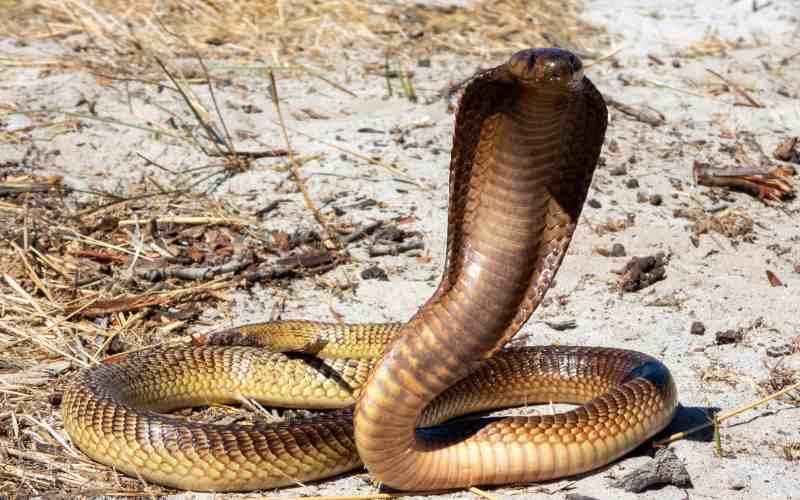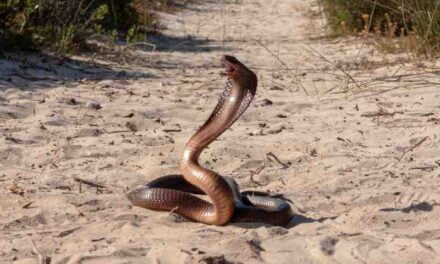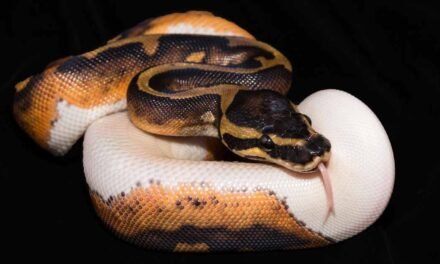Cape Coral, Florida, is known for its unique and diverse wildlife, including various snake species. Among these, the Cape Coral Cobra (Naja nivea) stands out due to its striking appearance and venomous nature. However, it’s essential for residents and visitors to be able to distinguish Cape Coral Cobras from other venomous snakes found in the region. In this blog, we will explore the key characteristics that can help you identify Cape Coral Cobras and differentiate them from other venomous snakes.
Cape Coral Cobra (Naja nivea)
Cape Coral Cobras are small to medium-sized snakes, typically measuring between 2 to 4 feet in length. Here are some identifying features:
- Coloration: Cape Coral Cobras have jet-black scales with cream or yellowish bands that encircle their bodies. These bands are particularly noticeable and are a distinguishing feature.
- Head Shape: Their heads are somewhat flattened and elongated, with a distinct hood that they can flare when threatened.
- Behavior: When threatened, Cape Coral Cobras can raise the front part of their bodies, revealing their striking bands. They are known for their ability to spit venom accurately at perceived threats, using a combination of venom and muscle contractions to propel it towards the eyes of an aggressor.
Eastern Coral Snake (Micrurus fulvius)
The Eastern Coral Snake is another venomous snake found in Florida. It is important to differentiate it from the Cape Coral Cobra. Here are the key characteristics:
- Coloration: Eastern Coral Snakes have distinct bands of bright red, yellow, and black. The red and yellow bands touch each other, and the black bands are separated by the yellow bands.
- Head Shape: Unlike the Cape Coral Cobra, coral snakes have small, rounded heads, and they lack the ability to flare a hood.
- Behavior: Coral snakes are generally non-aggressive and prefer to hide rather than confront threats. They are not known for spitting venom.
Eastern Diamondback Rattlesnake (Crotalus adamanteus)
The Eastern Diamondback Rattlesnake is one of the most significant venomous snakes in the southeastern United States. To distinguish it from Cape Coral Cobras:
- Size: Eastern Diamondbacks are much larger, with adults reaching lengths of 3 to 7 feet.
- Coloration: They have a diamond-shaped pattern along their backs, with a series of cream or yellowish scales bordered by dark bands.
- Tail: This snake has a distinctive rattle on its tail, which is a clear sign of a rattlesnake.
Water Moccasin (Agkistrodon piscivorus)
Also known as the Cottonmouth, the Water Moccasin is a venomous snake commonly found in Florida’s wetlands. To differentiate it from Cape Coral Cobras:
- Coloration: Water Moccasins are usually dark brown or black with distinctive white or cream-colored mouths.
- Behavior: These snakes are semi-aquatic and are often found near water. They are known for their aggressive behavior when cornered or provoked.
Conclusion
Identifying venomous snakes like the Cape Coral Cobra is essential for your safety and the well-being of the snakes themselves. Cape Coral Cobras are distinctive due to their jet-black coloration and cream or yellowish bands, as well as their ability to spit venom when threatened. Understanding the key features that distinguish them from other venomous snakes, such as the Eastern Coral Snake, Eastern Diamondback Rattlesnake, and Water Moccasin, can help you stay safe and protect these unique and vital species in Cape Coral’s ecosystem.
If you encounter a venomous snake and are unsure of its identity, it’s always best to keep a safe distance and avoid any attempts to handle or approach the snake. Instead, contact local wildlife authorities or experts who can safely assess and manage the situation.









